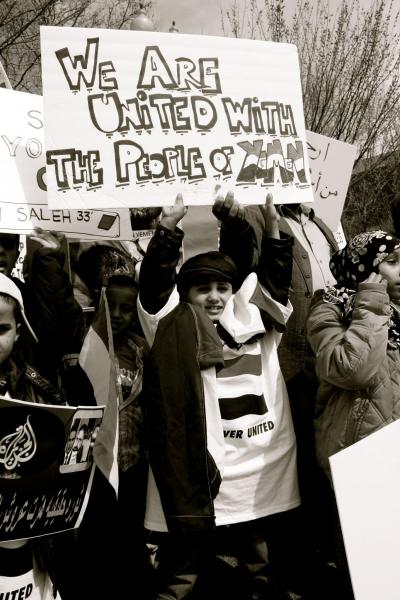Another Light Shines: Arab Spring in Yemen

In the wee hours of March 18, I was glued to Al Jazeera Arabic, transfixed as bloodied body after bloodied body was carried into a masjid, or small mosque, set up as a hospital near Sana’a University in Yemen. The footage was harrowing—images of demonstrators with bullet wounds to the head from snipers surrounding the square. March 18 marks one of the bloodiest days of the revolution in Yemen thus far.
Sadly, anyone paying attention to the region knew that a day like this was inevitable. Autocratic regimes are being threatened by popular uprisings, with only calls of “concern” or “investigation” following brutal crackdowns. It is all very predictable. But how did we get here?
The situation in Yemen is multi-layered, and politics in the country can seem complicated to outsiders. State control is weak, and to a certain degree Yemen remains haunted by regional divisions. Though the demands of the demonstrators in Yemen align with the pro-democracy movements springing up elsewhere in the Middle East and North Africa, in many ways, Yemen is different. The opposition is composed of several groups that compete with each other as often as they cooperate.
In the south, a peaceful protest movement that began in 2007 (but dates back to the 1994 civil war) calls for a more equitable distribution of state resources and political power. But these demands have been met with such repressive force that many are now loudly calling for secession. The long-running conflict in the northern province of Sa’da has entered into its sixth ceasefire in just seven years. There, the government has carried out indiscriminate attacks, including aerial bombing and the deployment of ground troops. Then there is the United States’ biggest concern: al-Qaeda in the Arabian Peninsula (AQAP), the only affiliated group that has attempted to launch (albeit failed) terrorist plots aimed at the United States. The recent rounds of civilian protests, however, began with the students of Sana’a University and were quickly joined by the Joint Meeting Parties and other political opposition parties.
Despite divergent interests, the demands of the opposition movement are substantive and display unified distrust for Ali Abdullah Saleh’s regime. It is only a matter of time before something breaks in Yemen: Either President Saleh leaves and the country can embark on a new chapter (he is the Arab world’s longest serving leader, after Libya’s Muammar Gaddafi) or there is more bloodshed. I believe the peaceful nature of the demonstrations, even in the face of brutal force, points toward a hopeful resolution. I am also heartened by the dialogue among diverse Yemeni-American communities, which show a strong sign of solidarity here in the United States that can be representative of a stable and unified Yemen.
As a Yemeni-American, I watch from abroad as my parents’ homeland inches closer to a vision of a new government, more responsive to the needs of the people and not corruption. I am inspired by the energy of the youth activists and feel an obligation to support their movement as I can, despite being thousands of miles away. Week after week, family, friends, and I attend rallies, speak with reporters and news agencies, blog, and spread the word about Yemen. We gather and discuss how we can positively contribute to the efforts of the brave demonstrators. Recently, I spoke with a Yemeni-American who is engaged in organizing efforts. He reiterated the “important role [we have] in ensuring that the plight of Yemenis is recognized abroad and especially in the U.S.” He noted that the community abroad “can be an important resource in supporting Yemen’s development … sharing their talents and expertise with the local Yemenis to help them develop effective institutions in education, health, and other sectors.”
The prospect of returning to Yemen to share in its future development excites and encourages me. But in the meantime, I continue to be transfixed by the television. As Yemen joins the “Arab Spring,” I, like millions of Yemenis around the globe, beam with pride at the example of our countrymen, women, and children whose civic participation and peaceful dissent in the face of brutal oppression are a shining light.
